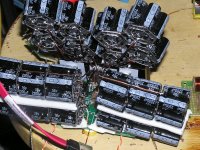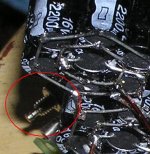Not if you go fast enough.I'll be 67 in June. You'll never catch up... I'll always be 10 years ahead.
-Richard Marsh
jn
Gee, Waly, now you know why I stick to discrete audio gain stages, for the most part. Of course, I have to do IC based designs as well, but they will never be as good as my discrete designs, AND all else being equal, I believe that my open loop designs are better than my high global negative feedback designs. Perhaps it starts making sense to those who care about the difference.
I knew that all along.
No, you are sticking with one topology (differential complementary jfets) built with unobtanium parts because:
1. What works, works.
2. It's your trademark in a fashion based audio industry. Kinda Christian Louboutin heels of audio. Same with "open loop designs", "high open loop bandwidth", etc...
3. There's no risk to get any significant competition, as long as the unobtanium part stocks are in the hands of a few chosen. How can you otherwise explain the reason for using 2SJ109 and 2SK389 in a design (JC-2) that is anything but about noise?
Do you really believe that all engineers and managers in the semi industry are a bunch of deaf idiots that can't tell their ears from a hole in the wall, therefore having zero interest in building any process compatible with your 30 years old topology? Flashnews: they don't do it simply because there's no business case and no real engineering arguments to do that. But I suspect you already know this, from your face-to-face and virtual engineering communities interactions in the last 10 years.
PMA, please, it is 'complicated' for most who look in here. They are not necessarily professional audio designers, like you, me, Nelson, Cordell, etc.
If I had a simpler complete schematic (proven to more or less work) I would have posted it. Even YOU PMA are somewhat confused by the schematic, or you would not have asked me about the asymmetrical loading.
If I had a simpler complete schematic (proven to more or less work) I would have posted it. Even YOU PMA are somewhat confused by the schematic, or you would not have asked me about the asymmetrical loading.
Yes I do, Waly, think that many electronic engineers are NOT good evaluators of hi fi equipment. They can be either biased by 'numbers', circuit sophistication, or that they are told that there cannot be any difference, this 'proven' by double blind tests.
Waly, I am an OLD MAN, 71 years old, retired for about 6 years, semi-retired for more than 20 years. It is NOT FOR ME to push forth with a significant change in the SAME DESIGN that I actually invented 40 years ago. It is superior in many ways, just ask PMA for his measurements. It, unfortunately, is just not very practical for extremely high quantity production such as 10's of thousands. I will leave that to YOU, Waly. IF you are up to it.
I don't want to die with the many thousands of 'exotic parts' some of whom first cost $0.79 and are now up to $15, in my personal inventory, AND my clients who are Parasound, Constellation, and Audible Difference, to name three, have their OWN stock of these 'exotic' devices and they will continue to use them IF it can be shown that they have a real advantage in audio design.
For you, Waly, perhaps Ferrari should scrap their engines and buy GM, in your opinion. After all, it would be cost effective, but would you get the same performance? I think not.
Now I am going to tell everyone, explicitly and openly, that IF I could make the best possible audio product just with augmented IC's, I would do so, immediately. In fact I am working on two products, right now, based on this premise. The JC 3 phono stage is also completely based on IC's. Still, the JC-3 will NOT beat a Vendetta Research discrete component design. How do I know? I A-B'd them in my own hi fi playback system, yet I am the designer of both and the circuit boards of both were made by my associate.
That's the way it goes, and I do not expect to live forever, so get wise, before I drop away.
Waly, I am an OLD MAN, 71 years old, retired for about 6 years, semi-retired for more than 20 years. It is NOT FOR ME to push forth with a significant change in the SAME DESIGN that I actually invented 40 years ago. It is superior in many ways, just ask PMA for his measurements. It, unfortunately, is just not very practical for extremely high quantity production such as 10's of thousands. I will leave that to YOU, Waly. IF you are up to it.
I don't want to die with the many thousands of 'exotic parts' some of whom first cost $0.79 and are now up to $15, in my personal inventory, AND my clients who are Parasound, Constellation, and Audible Difference, to name three, have their OWN stock of these 'exotic' devices and they will continue to use them IF it can be shown that they have a real advantage in audio design.
For you, Waly, perhaps Ferrari should scrap their engines and buy GM, in your opinion. After all, it would be cost effective, but would you get the same performance? I think not.
Now I am going to tell everyone, explicitly and openly, that IF I could make the best possible audio product just with augmented IC's, I would do so, immediately. In fact I am working on two products, right now, based on this premise. The JC 3 phono stage is also completely based on IC's. Still, the JC-3 will NOT beat a Vendetta Research discrete component design. How do I know? I A-B'd them in my own hi fi playback system, yet I am the designer of both and the circuit boards of both were made by my associate.
That's the way it goes, and I do not expect to live forever, so get wise, before I drop away.
... many electronic engineers are NOT good evaluators of hi fi equipment..
I'll second that. But one can not blame them - for many it's just a profession, a way to earn money, a skill learned only for that. "Regular" EE will be designing industrial robots today, RF stuff tomorrow, controller for coffee machine next month and Blue Ray player in one year. For such EE it doesn't make any difference what to design as long as he brings home some cash to feed the family.
Earning money by designing for such limited market as audio, especially "top end" takes courage and passion.
PMA, please, it is 'complicated' for most who look in here. They are not necessarily professional audio designers, like you, me,
You say that as if making a V from a mV of AF without too much distortion
and noise was the pinnacle of the art of electronics.
For me, some people play in a completely different league:
- those who make the ultrasonics to test the inner containment of
the nuclear power plant 35 miles from here,
- those who make the brake control electronics in my car and bike
- those wo make the transponder in the plane I fly
- those who built Voyager-1 40 years ago
- those who will design my heart pacemaker hopefully more than
20 years from now.
- a lot of others.
Such a bubble of hybris.
Gerhard
Gerhard, those people that you mention design for functionality. They do not design gear that has anything to do with human perception.
I have a good friend that does a lot in nuclear spectrometry field and is very good at it, but he is useless in audio. When he wanted to build a phono preamp some 20 years ago, his best effort was two audio ICs in parallel to improve the S/N ratio. :-D That was his way of addressing the problem. When I tell him what is being done in high-end circles, he thiks that we're nuts.
I have a good friend that does a lot in nuclear spectrometry field and is very good at it, but he is useless in audio. When he wanted to build a phono preamp some 20 years ago, his best effort was two audio ICs in parallel to improve the S/N ratio. :-D That was his way of addressing the problem. When I tell him what is being done in high-end circles, he thiks that we're nuts.
Last edited:
I'll second that. But one can not blame them - for many it's just a profession, a way to earn money, a skill learned only for that. "Regular" EE will be designing industrial robots today, RF stuff tomorrow, controller for coffee machine next month and Blue Ray player in one year. For such EE it doesn't make any difference what to design as long as he brings home some cash to feed the family.
Earning money by designing for such limited market as audio, especially "top end" takes courage and passion.
What a joke. There are certainly some engineers, in any field, who take little pride in what they do. However, there are many in all industries that have great passion for what they are working on.
Audio takes lots of courage, sure. It's quite courageous of Bybee to sell his potted resistors for that price.
Temco, Elektroj.
I see, thanks. You're also not bypassing LEDs with any capacitor. Is that because of the layout or are they ok without it?
I don't like capacitors. I use as few as possible.
I'm the opposite - my latest amp creation.
@Chris - I measured a few LEDs' dynamic impedance a while back - red were the lowest and about 10ohms was what I got. A TL431 is about 50X lower, probably a lot noisier though. I decided to stick with the TL in my designs as they can be adjusted.
Attachments
Last edited:
I'm the opposite - my latest amp creation.
And those are just the input coupling caps I presume?
se
Made up from 2200uF caps - you definitely bought them all!about 150,000uF per channel
BTW, is that a spark plug sticking out the side? How'd that get in there?
Attachments
- Status
- Not open for further replies.
- Home
- Member Areas
- The Lounge
- John Curl's Blowtorch preamplifier part II

